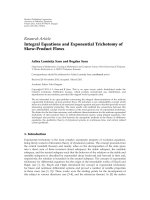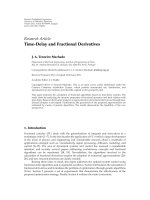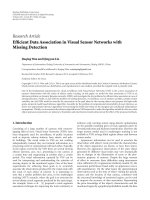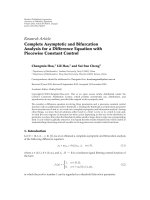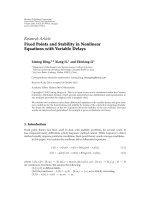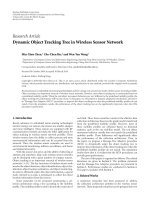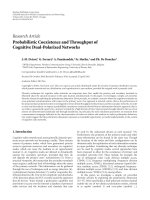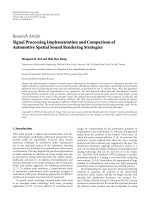Báo cáo hóa học: " Research Article Question Processing and Clustering in INDOC: A Biomedical Question Answering System" ppt
Bạn đang xem bản rút gọn của tài liệu. Xem và tải ngay bản đầy đủ của tài liệu tại đây (2.67 MB, 7 trang )
Hindawi Publishing Corporation
EURASIP Journal on Bioinformatics and Systems Biology
Volume 2007, Article ID 28576, 7 pages
doi:10.1155/2007/28576
Research Article
Question Processing and Clustering in INDOC:
A Biomedical Question Answering System
Parikshit Sondhi, Purushottam Raj, V. Vinod Kumar, and Ankush Mittal
Department of Electronics and Computer Engineering, Indian Institute of Technology Roorkee, Roorkee 247667, India
Received 12 April 2007; Accepted 22 September 2007
Recommended by Paola Sebastiani
The exponential growth in the volume of publications in the biomedical domain has made it impossible for an individual to keep
pace with the advances. Even though evidence-based medicine has gained wide acceptance, the physicians are unable to access
the relevant information in the required time, leaving most of the questions unanswered. This accentuates the need for fast and
accurate biomedical question answering systems. In this paper we introduce INDOC—a biomedical question answering system
based on novel ideas of indexing and extracting the answer to the questions posed. INDOC displays the results in clusters to help
the user arrive at the most relevant set of documents quickly. Evaluation was done against the standard OHSUMED test collection.
Our system achieves high accuracy and minimizes user effort.
Copyright © 2007 Parikshit Sondhi et al. This is an open access article distributed under the Creative Commons Attribution
License, which permits unrestricted use, distribution, and reproduction in any medium, provided the original work is properly
cited.
1. INTRODUCTION
An estimate of the around 14 million citations in PubMed
[1] database of National Library of Medicine clearly indi-
cates the exponential growth of published biomedical liter-
ature. It is thus impossible for any individual to keep pace
with the advances. Thus, though evidence-based medicine
has gained wide acceptance [2–5], the physicians are unable
to access the relevant information in the required time, leav-
ing most of the questions unanswered [6]. The problem is
further compounded by the inadequacy of the current search
engines to perform well with biomedical literature. In a study
conducted with a test set of 100 medical questions collected
from medical students in a specialized domain, a thorough
search in Google was unable to obtain relevant documents
within top five hits for 40% of the questions [7]. The current
search engines fail to satisfy a user’s need for primarily two
reasons.
(1) Focus is more on keyword matching rather than se-
mantics or relations between keywords.
(2) Lack of understanding of complex biomedical termi-
nology and its inconsistent use [8].
Hence there is a need to develop fast and effective ques-
tion answering systems for the biomedical domain [9–11].
A number of strategies have been proposed for answering
biomedical questions such as, answering by role identifica-
tion [5, 12, 13], and answering based on document structure
[14]. A survey of recent works can be found in [15].
In this paper, we present the design and implementation
of Internet Doctor (INDOC), a biomedical question answer-
ing system. The system involves modules to perform index-
ing, question processing, document ranking, clustering, and
display.
The paper is organized into 4 sections. The architecture
of the system is presented in Section 2. Section 3 presents the
performance analysis of the system and Section 4 describes
future work and the conclusions.
2. ARCHITECTURE OF INDOC
The architecture of INDOC is as shown in Figure 1. The en-
tire document set is first indexed by the indexing module. A
detailed explanation of the indexing method is given later. At
runtime, the query from the user is processed by the question
processing module recognizing the difference in significance
of different parts of the query, and the ranking module ranks
the documents by assigning weights on the basis of their rel-
evance to the question. Finally, the display module displays
the documents in a decreasing order of their weights. It also
2 EURASIP Journal on Bioinformatics and Systems Biology
ICD database
MMTX server
Question processing module
Weighing/ranking module
Indexing module
Document repository
Index
Clustering & display
User
Figure 1: Complete architecture of the system.
Figure 2: Screen-shot of the results.
Figure 3: Clustered display of the result-set.
Parikshit Sondhi et al. 3
clusters the result-set, marks the most relevant portions of
each document, and thus reduces the user effort required
in locating the answer. In order to tackle the problems with
complex biomedical terminology and its inconsistent use, we
have used the UMLS concepts [16] instead of keywords. The
task of parsing the text and returning the relevant concepts is
performed by MMTX [17], a programming implementation
of MetaMap [18].
2.1. MMT X server
The MMTX program is used to map the free text into cor-
responding UMLS concepts. This operation of concept map-
ping is performed both while indexing the documents and
while processing the query. However, as creating an MMTX
object is expensive and takes a considerable amount of time,
we implemented a server which instantiates an MMTX ob-
ject once and waits for free text (which may be either a query
string or a document) to be sent. It then returns back the
mapping concepts.
2.2. Indexing
Unlike other indexing techniques, we do not just select the
important keywords or concepts. Rather, the entire docu-
ment is represented in the form of sections as shown in
Section 2.2.1. Each section has a section heading and a num-
ber of sentences in it. The section heading consists of one
or more UMLS concepts that represent the section. Further,
only successive sentences can belong to a section and any in-
dividual sentence cannot be present in more than one sec-
tion. At the time of document retrieval, a document may be
considered useful if some or all of the question concepts are
present in one of the section headings. In order to minimize
the runtime overhead, we also store all the concepts present
in a document.
2.2.1. Indexed representation
Sample document
“Lack of attenuation of a candidate dengue 1 vaccine (45AZ5)
in human volunteers. A dengue type1, candidate live virus vac-
cine (45AZ5) was prepared by serial virus passage in fetal rhe-
suslungcells.Infectedcellsweretreatedwithamutagen,5-
azacytidine, to increase the likelihood of producing attenuated
variants. The vaccine strain was selected by cloning virus that
produced only small plaques in vitro and showed reduced repli-
cation at high temperatures (temperature sensitivity). Although
other candidate live dengue virus vaccines, selected for simi-
lar growth characteristics, have been attenuated for humans,
two recipients of the 45AZ5 virus developed unmodified acute
dengue fever. Viremia was observed within 24 hr of inoculation
and lasted 12 to 19 days. Virus isolates from the blood produced
largeplaquesincellcultureandshoweddiminishedtempera-
ture sensitiv ity. The 45AZ5 virus is unacceptable as a vaccine
candidate. This ex perience points out the uncertain relation-
ship between in vitro viral growth characteristics and virulence
factors for humans.”
Corresponding indexed form
Lacking (qualifier value)
|attenuation |Dengue |Vaccines
|Human Volunteers |
Lacking (qualifier value) |atte nuation |Dengue |Vaccines
|Human Volunteers|
00
Cells
|
12
Selection (Genetics)
|Virus|
35
Virus
|.
2.2.2. Algorithm
The algorithm to perform the task of indexing is shown in
Algorithm 1.
The algorithm begins by first obtaining all the concepts
in the title and storing them in the index file. This is done
as the title is usually a good indicator of the content of the
document.
The first phase involves formation of sections on the ba-
sis of concepts present in the sentences. It begins by adding
S
1
, the first sentence of the document to the section X
1
and
all its concepts SC
1
to XC
1
. We then add the next sentence
S
2
into X
1
and update the concepts in section heading to
XC
1
= XC
1
∩ SC
2
. The section heading thus contains the
concepts common to both the sentences. This process is car-
ried out till we find a sentence S
j
for which XC
1
∩ SC
j
is an
emptyset.However,theabovestepsdonealoneleaveaprob-
lem unsolved.
Suppose a section X
i
has m (m is large) sentences and
the concept set XC
i
has n1 concepts. Thus effectively m sen-
tences are relevant to n1concepts.Nowifwetrytoaddanew
sentence S
j
to the current section X
i
such that |XC
i
∩ SC
j
|=
n2(n2 <n1), we miss out n1-n2 concepts which are also used
frequently in the section.
In order to avoid this, we define a constant M which is
the minimum number of sentences to help us decide when
to add a new sentence.
(1) For
|X
i
| <M—the sentence is added if it contains at
least one of the concepts present in the section head-
ing.
(2) For
|X
i
| >M—the sentence is added if it contains all
the concepts present in the section heading, otherwise,
we start constructing a new section X
i+1
.
Once the formation of sections is complete, we need to
perform the task of section merging. This step is necessary
because of the following.
(1) The size of some sections may become too small. In
the extreme case, we might end up with just a single
sentence in a section. To handle this we define L, the
minimum number of sentences to be present in a sec-
tion. If for a section X
i
, |X
i
| <Lthen we merge it with
the previous section X
i−1
. Since |X
i
| is very small, the
concepts in the set XC
i
are not of much importance
and hence can be discarded.
4 EURASIP Journal on Bioinformatics and Systems Biology
1. Obtain the concepts of the title and store them.
2. Initialize i
= 1and j = 1, and set all X
i
, SC
j
, XC
i
to be empty where
S
j
: jth sentence in the document
X
i
: ith section
SC
j
: set of concepts in jth sentence (concepts in
an individual sentence)
XC
i
: set of concepts in ith section
L: min number of sentences necessary in a
section
M: minimum number of sentences in a section
so that merging is not necessary
3. Formation of sections
Set XC
i
to concepts in the first sentence.
Define
|S| as the number of elements in set S.
For each sentence S
j
left in the document to
process
{
If (|X
i
|==0){
Add S
j
to X
i
Add SC
j
to XC
i
}
else {
if ((|X
i
| <M&&|XC
i
∩ SC
j
| > 0)
XC
i
== SC
j
)
{
Add S
j
to X
i
Set XC
i
= XC
i
∩ SC
j
}
else{
i = i +1
Add S
j
to the new section X
i
Add SC
j
to XC
i
}
}
}
4. Final section merging step
for each section X
i
{
If (i>1&&(|X
i
| <L|XC
i
is a subset
of XC
i−1
)){
Merge X
i
with X
i−1
}
}
Algorithm 1
(2) There may be cases where XC
i
is a subset of XC
i−1
.In
such scenarios, X
i
will be merged with X
i−1
.
In either case, the set XC
i−1
is left unchanged.
For scaling the algorithm to a large document set, we
need to maintain a Concepts X Document matrix containing
the section-heading concepts and the corresponding docu-
ments in which they are present. This would save us the ex-
pense of performing large file operations on indexed files of
all documents that need to be done while answering the ques-
tion. For the evaluation performed by us, since the document
set was not excessively large, we could get equally good per-
formance even without such matrix.
2.3. Question processing
The query input by the user is sent to the MMTX server
which returns back the UMLS concepts present in it. For ex-
ample,
Question
Tell me about pathophysiology and treatment of dissemi-
nated intravascular coagulation.
Concepts
Disseminated Intravascular Coagulation, Therapeutic pro-
cedure, physiopathological, therapeutic aspects.
However, all the key-concepts are not equally important.
In the above example, the concept “disseminated intravascu-
lar coagulation” is of higher importance as compared to the
rest. Therefore, different concepts need to be assigned dif-
ferent weights based on their relative importance, which is
decided from their semantic type [19, 20]. In order to iden-
tify the relative importance of the semantic types, we an-
alyzed 106 biomedical questions from the OHSUMED test
collection [21]. The results are as shown in Table 1 ,where
frequency of various semantic groups in the questions is pre-
sented.
From this analysis, it is quite clear that most questions
are centered on concepts & ideas (CONC), disorders (DISO),
and procedures (PROC); and therefore these semantic types
are given higher weights.
In general, the mapped concepts from MMTx alone do
not capture all the related senses of a key-concept. For exam-
ple, back pain and lower back pain are mapped differently,
thus a query for lower back pain will not look for back pain
and vice versa. We have used the disease classification from
the ICD-9-CM to deal with this problem.
2.4. ICD database of related terms
The query concepts with the highest weights are sent to the
ICD-9-CM database to obtain a set of related concepts. The
search for relevant documents is done on the basis of all these
concepts along with the original concepts in the query.
ICD-9-CM stands for International Classification of Dis-
eases, Ninth Revision, Clinical Modification. It is based on
the World Health Organization’s Ninth Revision, Interna-
tional Classification of Diseases (ICD-9). It is the official sys-
tem of assigning codes to diagnoses and procedures associ-
ated with hospital utilization in the United States [22].
The ICD-9-CM consists of:
(i) A numerical list of the disease code numbers in tabular
form;
(ii) An alphabetical index to the disease entries; and
(iii) A classification system for surgical, diagnostic, and
therapeutic procedures (alphabetic index and tabular
list).
Parikshit Sondhi et al. 5
Table 1: Analysis of questions.
Abbriviation Semantic group Frequency
ACTI Activities & behaviors 27
ANAT Anatomy 13
CHEM Chemicals & drugs 58
CONC Concepts & ideas 137
DEVI Devices 1
DISO Disorders 144
GENE Genes & molecular sequences 0
GEOG Geographic areas 0
LIVB Living beings 9
OBJC Objects 2
ORGA Organizations 0
OCCU Occupations 2
PHEN Phenomena 3
PHYS Physiology 9
PROC Procedures 89
All terms in the same parental three-digit code are related
and a search can be made for all of these terms whenever
a search for any disease in a group is made. For example,
Cholera is given code 001 with the following subclassifica-
tions.
(i) 001 cholerae
(ii) 001.0 Due to Vibrio cholerae
(iii) 001.1 Due to Vibrio cholerae el tor
(iv) 001.9 Cholera, unspecified.
Using ICD database the focus terms (Disseminated
Intravascular Coagulation, Therapeutic procedure, phys-
iopathological, therapeutic aspects) of the question men-
tioned in the previous section are expanded into the follow-
ing set.
“Disseminated Intravascular Coagulation, Therapeutic
procedure, physiopathological, therapeutic aspects, Acquired
coagulation factor de ficiency NOS (disorder), Afibrinogene-
mia, Antithromboplastino-genemia, Blood Coagulation Dis-
orders, Blood Coagulation Factor, Blood coagulation p ath-
way obs ervation, Blood coagulation tests, Circulating antico-
agulants, Coagulation Therapy, Coagulation factor deficien-
cies, Coagulation procedure, Congenital deficiency (morpho-
logic abnormality), coagulation, Disseminated Intravascular
Coagulation, Dysfibrinogenemia (disorder), Fibrinogen, Hem-
orrhagic Disorders, Hemorrhagic disorder due to antithrom-
binemia (disorder), Hemostasis procedure, Pathologic fibrinol-
ysis, Thrombolytic Therapy, Thromboplastin, Unfractionated
hepar in (substance).”
After the question processing is performed with the help
of this diseases classification, we proceed to the document
retrieval and their subsequent ranking.
2.5. Document ranking
This step involves assigning the documents a weight on the
basis of their relevance to the question. For each document,
we search the index file to see which section headings match
the question concepts. We are interested in sections whose
headings have at least one of the question concepts. The cor-
responding sentences are checked to see if they contain any
more of the question concepts, which are not present in the
heading. Thus, the score of each section is the sum of weights
of question concepts present in it. If matches are found in
two consecutive sections then they can be combined to form
a bigger section, so as to highlight them together while pro-
viding the answer. Further, we can also include the neighbor-
ing sections of a selected section in order to ensure that no
relevant sentences are skipped.
Weight of the document Wd is given by the (1):
Wd
= Nd + log
10
(NI), (1)
where Nd
= sum of weights of all the matched concepts in
the best section and Nl
= number of lines in the best section.
Here, by best section, we refer to the section that has the
maximum total weight of question concepts.
We justify the importance of Nl as it gives a measure of
the relevant information in the current document. Between
two documents with same number of concept matches, the
document with higher value of Nl contains more informa-
tion.
Logarithm of Nl is taken because Nd, the total weight of
all concept matches, is of higher significance. Since the doc-
ument weight (Wd) is calculated on the basis of concepts
present in the best section and not in the entire document,
we are sure that the concepts appear in proximity, and are
not just arbitrarily present.
2.6. Clustering
We clustered the final document set so as to make it easier for
the user to arrive at the most relevant set of documents, not
just one best document.
For clustering the documents, we employed k-means
clustering. The algorithm steps [23]areasfollows.
(i) Choose the number of clusters, k.
(ii) Randomly generate k clusters and determine the clus-
ter centers, or directly generate k random points as
cluster centers.
(iii) Assign each point to the nearest cluster center.
(iv) Recompute the new cluster centers.
(v) Repeat the two previous steps, stopping when the as-
signment does not change anymore.
The maximum number of clusters to be formed can ei-
ther be fixed beforehand or specified separately for each
query by the user. For our analysis, we fixed the number of
clusters to four.
The distance measure used for clustering is Euclidean,
based on the occurrence of key-concepts present in the ques-
tion. Each document is represented in terms of a vector of
weights that are decided according to the respective semantic
types.
Further, while determining the centers initially in the sec-
ondstepofk-means algorithm, we biased centers, so that first
one-fourth documents in the ranked list go into the first clus-
ter, the next one-fourth in the second, and so on.
6 EURASIP Journal on Bioinformatics and Systems Biology
The cluster that contains the top-ranked document is
suggested to the user as the cluster most relevant to the query.
2.7. Displaying the results
The documents are finally displayed in descending order of
weights. The most relevant sentences are highlighted. Thus
the user effort required to locate the answer is minimized.
3. EVALUATION
For the sake of evaluating our system, we used the standard
OHSUMED collection which is used extensively in informa-
tion retrieval research.
3.1. About OHSUMED collection
The OHSUMED test collection [21] was created to assist in-
formation retrieval research. It is a clinically-oriented Med-
line subset, consisting of 348,566 references (out of a total
of over 7 million), covering all references from 270 medi-
cal journals over a five-year period (1987–1991). The collec-
tion includes 106 queries generated using Medline by novice
physicians. It also includes 12,565 unique query-reference
pairs obtained after judgment for relevance. We used a subset
of around 7000 documents from this collection as the docu-
ment repository and the 101 queries as the questions for IN-
DOC. Five queries were left out as our subset of documents
did not contain an answer for them.
3.2. Performance evaluation and results
To evaluate our system, we compare the results returned by
our system with the query-document pairs that have been
judged for relevance. The OHSUMED collection includes
the file drel.i that contains the query-document pairs rated
as definitely relevant, with documents listed by sequential
number in the format (<query><tab><document-i>). Cor-
responding to each query, we select the set of documents
judged as definitely relevant as the set of correct documents
and evaluate our results against this set. We illustrate the re-
sults in Ta ble 2 .
We observed that 58.4% of the questions posed were an-
swered correctly by the first document itself. We also noted
that the top 5 ranked documents have answers to 76.23% of
all the queries.
Ta ble 2 illustrates cumulative percentage of the queries
answered, against the rank of documents.
For example for 81.18% of the queries, the first relevant
result was obtained within top 10 results.
In total, we used 6637 documents and the system was able
to answer 93.07% of the queries posed. No answer could be
retrieved for 7 questions.
On an average, 54.79% of relevant documents were cor-
rectly identified by the system (Recall).
Table 2: Experimental results of our system on OHSUMED dataset.
Rank of first answer Number of queries % answered correctly
1 59 58.4
2 70 69.3
3 75 74.2
4 76 75.24
5 77 76.23
10 82 81.18
50 84 83.17
4. CONCLUSIONS AND FUTURE WORK
In this paper, we presented an effective implementation of
a biomedical question answering system. We devised meth-
ods for query processing, document indexing and procedures
for extracting the answer to the questions posed. The system
was evaluated against the standard OHSUMED test collec-
tion and high performance (93.07% correctly answered, out
of which 76.23% were answered within the top 5 documents)
was obtained. We minimized the user effort by clustering the
result set, identifying the most relevant sentences, and high-
lighting them. The technique and system presented in this
paper can be useful in designing a new generation efficient
framework for biomedical question answering system.
Apart from the ideas presented in this paper, there are
some improvements possible on the present system. First the
question’s taxonomy as given in [24] can be implemented.
Questions about patient care can be organized into a lim-
ited number of generic types, which could help guide the ef-
forts of knowledge base developers. These generic types can
be used in finding excerpts from the documents as short an-
swers to the questions posed.
Secondly, the system relies on effective generation of
heading concepts for each subsection as described in the pro-
posed algorithm. From the algorithm, it is clear that any
anaphora in sentences referring to potential heading con-
cepts are not taken care of and they have to be dealt with
to ensure effective indexing. As such, anaphora resolution is
by large an unsolved problem. Addressing the problem of re-
solving Anaphora problem can be a potential area for future
work.
REFERENCES
[1] />[2] P. Gorman, J. Ash, and L. Wykoff,“Canprimarycarephysi-
cians’ questions be answered using the medical journal litera-
ture?” Bulletin of the Medical Library Associat ion , vol. 82, no. 2,
pp. 140–146, 1994.
[3] S. E. Straus and D. L. Sackett, “Bringing evidence to the point
of care,” Journal of the American Medical Association, vol. 281,
pp. 1171–1172, 1999.
[4] G. H. Guyatt, M. O. Meade, R. Z. Jaeschke, D. J. Cook, and
R. B. Haynes, “Practitioners of evidence based care,” British
Medical Journal, vol. 320, no. 7240, pp. 954–955, 2000.
[5]D.L.Sackett,S.E.Straus,W.S.Richardson,W.Rosenberg,
andR.B.Haynes,Evidence-Based Medicine: How to Practice
Parikshit Sondhi et al. 7
and Teach ENB, Churchill Livingstone, New York, NY, USA,
1997.
[6] P. N. Gorman and M. Helfand, “Information seeking in pri-
mary care: how physicians choose which clinical questions
to pursue and which to leave unanswered,” Medical Decision
Making, vol. 15, no. 2, pp. 113–119, 1995.
[7] P. Jacquemart and P. Zweigenbaum, “Towards a medical
question-answering system: a feasibility study,” in Proceedings
of Medical Informatics Europe (MIE ’03),P.L.BeuxandR.
Baud, Eds., vol. 95 of Studies in Health Technology and Infor-
matics, pp. 463–468, IOS Press, San Palo, Calif, USA, 2003.
[8] S. Schultz, M. Honeck, and H. Hahn, “Biomedical text re-
trieval in languages with complex morphology,” in Proceedings
of the Workshop on Natural Language Processing in the Biomed-
ical domain, pp. 61–68, Philadelphia, Pa, USA, July 2002.
[9] J.Ely,J.A.Osheroff, and M. H. Ebell, “Analysis of questions
asked by family doctors regarding patient care,” British Medical
Journal, vol. 319, no. 7206, pp. 358–361, 1999.
[10] J. W. Ely, J. A. Osheroff,M.H.Ebell,etal.,“Obstaclestoan-
swering doctors’ questions about patient care with evidence:
qualitative study,” British Medical Journal, vol. 324, no. 7339,
pp. 710–713, 2002.
[11] G.R.Bergus,C.S.Randall,S.D.Sinift,andD.M.Rosenthal,
“Does the structure of clinical questions affect the outcome of
curbside consultations with specialty colleagues?” Archives of
Family Medicine, vol. 9, no. 6, pp. 541–547, 2000.
[12] Y. Niu and G. Hirst, “Analysis of semantic classes in medical
text for question answering,” in Proceedings of the 42nd Annual
Meeting of the Association for Computational Linguistics, Work-
shop on Question Answering in Restricted Domains, pp. 54–61,
Barcelona, Spain, July 2004.
[13] Y. Niu, G. Hirst, G. McArthur, and P. Rodriguez-Gianolli, “An-
swering clinical questions with role identification,” in Proceed-
ings of 41st Annual Meeting of the Association for Computa-
tional Linguistics, Workshop on Natural Language Processing in
Biomedicine, pp. 73–80, Sapporo, Japan, July 2003.
[14] E. T. K. Sang, G. Bouma, and M. De Rijke, “Developing of-
fline strategies for answering medical questions,” in Proceed-
ings of the AAAI-05 Workshop on Question Answering in Re-
stricted Domains, vol. WS-05-10, pp. 41–45, Pittsburgh, Pa,
USA, 2005.
[15] A. M. Cohen and W. R. Hersh, “A survey of current work
in biomedical text mining,” Briefings in Bioinformatics, vol. 6,
no. 1, pp. 57–71, 2005.
[16] />[17] />[18] A. R. Aronson, “Effective mapping of biomedical text to the
UMLS Metathesaurus: the MetaMap program,” in Proceedings
of the AMIA Symposium, pp. 17–21, 2001.
[19] A. T. McCray, A. Burgun, and O. Bodenreider, “Aggregating
UMLS semantic types for reducing conceptual complexity,”
Medinfo, vol. 10, part 1, pp. 216–220, 2001.
[20] O. Bodenreider and A. T. McCray, “Exploring semantic groups
through visual approaches,” Journal of Biomedical Informatics,
vol. 36, no. 6, pp. 414–432, 2003.
[21] W. R. Hersh, “OHSUMED: an interactive retrieval evaluation
and new large test collection for research,” in Proceedings of
the 17th Annual International ACM SIGIR Conference on Re-
search and Development in Information Retrieval (SIGIR ’94),
pp. 192–201, Springer, Dublin, Ireland, July 1994.
[22] />[23] J. B. MacQueen, “Some methods for classification and analysis
of multivariate observations,” in Proceedings of 5th the Berke-
ley Symposium on Mathematical Statist ics and Probability,
pp. 281–297, University of California Press, Berkeley, Calif,
USA, June-July 1967.
[24] J. W. Ely, J. A. Osheroff,P.N.Gorman,etal.,“Ataxonomyof
generic clinical questions: classification study,” British Medical
Journal, vol. 321, no. 7258, pp. 429–432, 2000.
